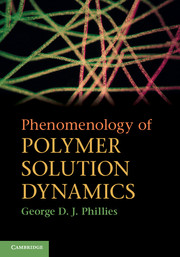Book contents
- Frontmatter
- Contents
- Preface
- 1 Introduction
- 2 Sedimentation
- 3 Electrophoresis
- 4 Quasielastic light scattering and diffusion
- 5 Solvent and small-molecule motion
- 6 Segmental diffusion
- 7 Dielectric relaxation and chain dimensions
- 8 Self- and tracer diffusion
- 9 Probe diffusion
- 10 Dynamics of colloids
- 11 The dynamic structure factor
- 12 Viscosity
- 13 Viscoelasticity
- 14 Nonlinear viscoelastic phenomena
- 15 Qualitative summary
- 16 Phenomenology
- 17 Afterword: hydrodynamic scaling model for polymer dynamics
- Index
- References
17 - Afterword: hydrodynamic scaling model for polymer dynamics
Published online by Cambridge University Press: 05 August 2012
- Frontmatter
- Contents
- Preface
- 1 Introduction
- 2 Sedimentation
- 3 Electrophoresis
- 4 Quasielastic light scattering and diffusion
- 5 Solvent and small-molecule motion
- 6 Segmental diffusion
- 7 Dielectric relaxation and chain dimensions
- 8 Self- and tracer diffusion
- 9 Probe diffusion
- 10 Dynamics of colloids
- 11 The dynamic structure factor
- 12 Viscosity
- 13 Viscoelasticity
- 14 Nonlinear viscoelastic phenomena
- 15 Qualitative summary
- 16 Phenomenology
- 17 Afterword: hydrodynamic scaling model for polymer dynamics
- Index
- References
Summary
This very short chapter sketches a theoretical scheme – the hydrodynamic scaling model – that is consistent with the results in the previous chapter, and that predicts aspects of the observed behavior of polymers in nondilute solution. The model is incomplete; it does not predict everything. However, where it has been applied, its predictions agree with experiment. Here the model and its developments as of date of writing are described qualitatively, the reader being referred to the literature for extended calculations.
The hydrodynamic scaling model is an extension of the Kirkwood-Riseman model for polymer dynamics(1). The original model considered a single polymer molecule. It effectively treats a polymer coil as a bag of beads. For their collective coordinates, the beads have three center-of-mass translations, three rotations around the center of mass, and unspecified other coordinates. The use of rotation coordinates causes the Kirkwood-Riseman model to differ from the Rouse and Zimm models(2, 3). The other collective coordinates of the Kirkwood–Riseman model are lumped as “internal coordinates” whose fluctuations are in first approximation ignored. The beads are linked end-to-end, the links serving to establish and maintain the coil's bead density and radius of gyration. However, the spring constant of the links only affects the time evolution of the internal coordinates; it has no effect on translation or rotation of the coil as a whole.
When a coil moves with respect to the solvent, each bead sets up a wake, a fluid flow described in first approximation by the Oseen tensor.
- Type
- Chapter
- Information
- Phenomenology of Polymer Solution Dynamics , pp. 494 - 498Publisher: Cambridge University PressPrint publication year: 2011



